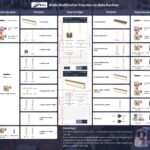A derate code on your Peterbilt indicates a serious issue with your engine, often related to emissions. Understanding how to address this problem is crucial for getting your truck back on the road. This guide will walk you through the process of clearing an engine derate on a Peterbilt.
While this article focuses on Peterbilt, the general principles and troubleshooting steps can apply to other heavy-duty diesel trucks as well. Always consult your specific truck’s manual for detailed instructions and safety precautions.
Understanding Engine Derate
An engine derate, also known as derating or power reduction, is a protective mechanism in modern diesel engines. It limits engine power to prevent further damage when a critical system malfunction is detected, usually within the emissions system. Ignoring a derate can lead to costly repairs and even engine failure.
Common Causes of Peterbilt Engine Derate
Several factors can trigger an engine derate in a Peterbilt. The most common culprits include problems with the following components:
- Aftertreatment System: Issues with the Diesel Particulate Filter (DPF), Diesel Exhaust Fluid (DEF) system (including low DEF levels, incorrect DEF quality, or DEF system malfunctions), or Selective Catalytic Reduction (SCR) system.
- Sensors: Faulty sensors, such as the exhaust gas temperature sensor, NOx sensor, or DPF pressure sensor, can provide inaccurate readings, leading to derate.
- Fuel System: Problems with fuel pressure, injectors, or other fuel system components.
- Engine Control Module (ECM): While less common, a malfunctioning ECM can also cause a derate.
How to Clear Engine Derate Peterbilt: A Step-by-Step Guide
Clearing a derate code involves more than just resetting it. You must address the underlying problem that triggered the derate in the first place. Here’s a step-by-step guide:
-
Read Fault Codes: Use a diagnostic tool compatible with Peterbilt engines (such as those from TEXA or Cojali) to read the specific fault codes stored in the ECM. These codes will pinpoint the source of the problem.
-
Diagnose the Problem: Based on the fault codes, diagnose the issue. This may involve inspecting components, checking wiring, or using specialized diagnostic equipment. Consult your truck’s service manual for detailed troubleshooting procedures.
-
Repair the Issue: After identifying the root cause, perform the necessary repairs. This could involve replacing faulty sensors, cleaning or replacing the DPF, refilling DEF, or addressing other mechanical or electrical problems.
-
Clear the Fault Codes: Once the repairs are complete, use the diagnostic tool to clear the fault codes from the ECM’s memory.
-
Verify the Repair: After clearing the codes, run the engine and monitor its performance to ensure the derate condition is resolved. If the derate returns, further diagnosis is necessary. Sometimes a derate counter needs to be reset within the diagnostic software. This counter tracks the number of times a fault has occurred.
Preventing Future Engine Derates
Regular maintenance is key to preventing future derate situations. This includes:
- DPF Regeneration: Ensure the DPF regenerates properly.
- DEF Maintenance: Maintain proper DEF levels, use the correct DEF fluid, and ensure the DEF system is functioning correctly.
- Regular Inspections: Regularly inspect critical components for wear and tear.
- Promptly Address Warning Lights: Don’t ignore warning lights on the dashboard.
Conclusion
Clearing an engine derate on a Peterbilt requires addressing the underlying problem, not just resetting the code. Utilizing a diagnostic tool and following proper troubleshooting procedures are essential. By understanding the common causes of derates and implementing preventative maintenance practices, you can minimize downtime and keep your Peterbilt running smoothly.

